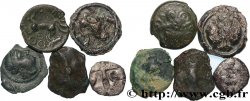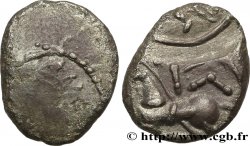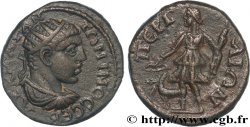v29_0581 - TESORO DI BRIDIERS (CREUSE) Drachme de Bridiers à la tête d’Apollon
MONNAIES 29 (2007)
Начальная цена : 250.00 €
Назначить цену : 450.00 €
непроданный лот
Начальная цена : 250.00 €
Назначить цену : 450.00 €
непроданный лот
Тип Drachme de Bridiers à la tête d’Apollon
Дата: IIe siècle avant J.-C.
Металл: silver
Диаметр: 16 mm
Ориентация осей монеты: 2 h.
Вес: 3,73 g.
Редкость: R3
Комментарии о состоянии
Monnaie sur un flan un peu court et épais, avec un manque de métal à 12 heures au revers. Frappe décentrée des deux côtés. Usure importante, surtout au revers (difficilement identifiable), avec un métal granuleux. Un coup ou une rayure est à noter sous l'œil au droit
Ссылки в каталоге: :
Лицевая сторона
Аверс: легенда: ANÉPIGRAPHE.
Аверс: описание: Tête d’Apollon laurée à droite.
Обратная сторона
Реверс: легенда: ANÉPIGRAPHE.
Реверс: Описание: Animal hybride dérivé du lion des drachmes de Marseille ; (chaudron au-dessus ; ligne d’exergue).
Комментарий
Bien que très usée et un peu légère, cette monnaie est à rattacher aux drachmes au lion et au chaudron du trésor de Bridiers. L'usure importante et le manque de métal du revers justifient le poids léger, à moins qu'il s'agisse d'une frappe plus tardive avec un affaiblissement du poids ?.








 Cообщить об ошибке
Cообщить об ошибке Распечатать страницу
Распечатать страницу Отправить мой выбор
Отправить мой выбор Задать вопрос
Задать вопрос Consign / sell
Consign / sell










